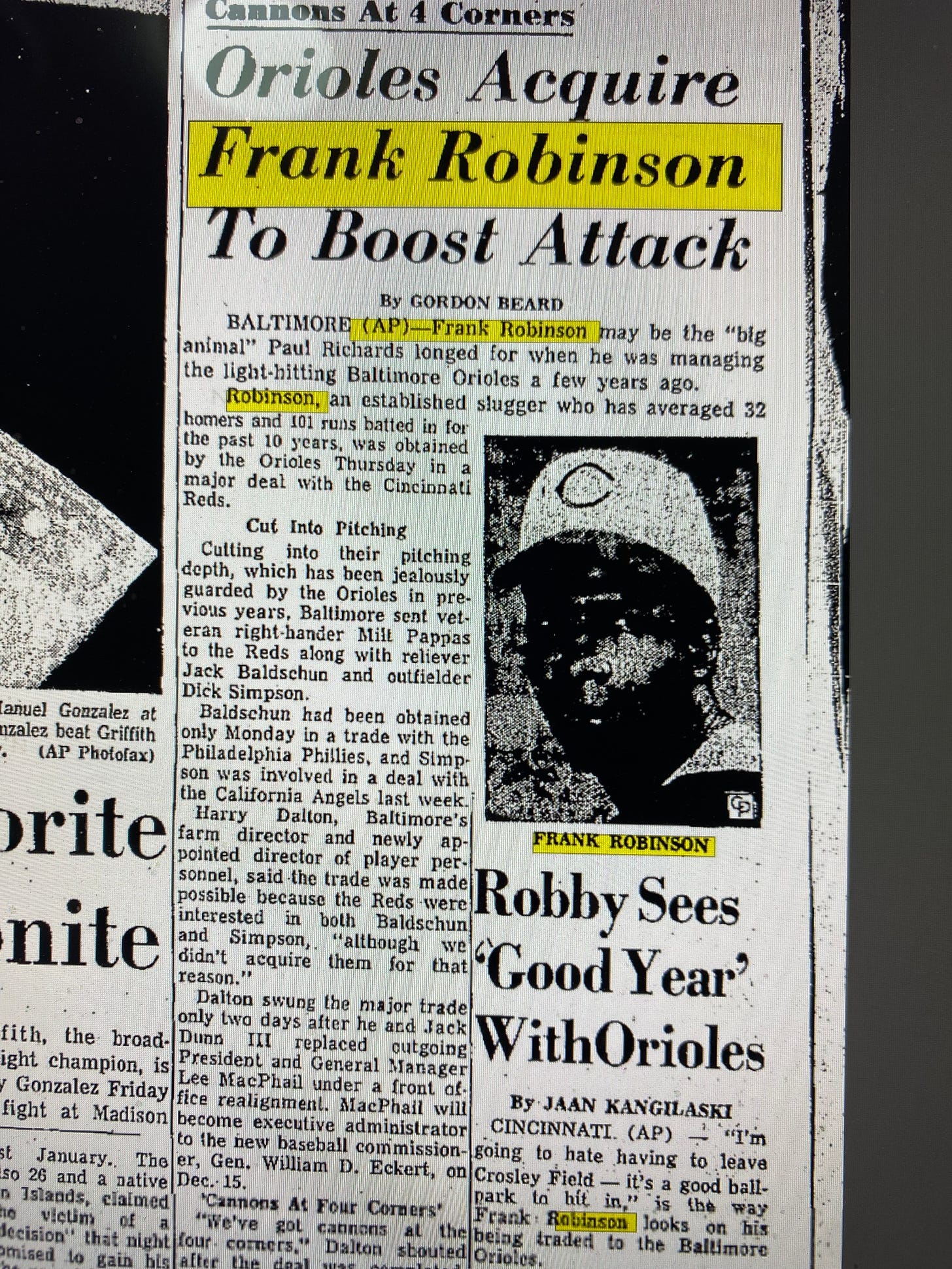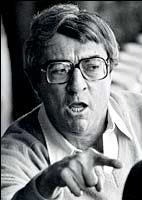The Man Behind the Curtain (From the Archive)
Jim Russo, the Orioles' masterful talent evaluator, was renowned for his many and varied contributions over 33 years, but his important role in the team's greatest trade isn't widely known.
In a conventional account of the Orioles’ momentous trade for Frank Robinson, several executives get the credit.
Lee MacPhail, in his final weeks as the team’s director of player personnel, negotiated back and forth with the Cincinnati Reds before leaving for a job in the commissioner’s office in December of 1965, having not made the deal.
Harry Dalton, who replaced MacPhail as director of player personnel, finalized the terms and pulled the trigger on the trade shortly after he took over.
Robinson came to the Orioles in exchange for Milt Pappas, Baltimore’s top starting pitcher; Jack Baldschun, a back-end relief pitcher; and Dick Simpson, a young outfielder. The Orioles had acquired Baldschun and Simpson just days earlier.
The deal altered the very nature of the American League. The New York Yankees had ruled for decades, but their dynasty was ebbing. The Orioles assumed the dominant role with Robinson, winning four pennants and two World Series titles in the next six years.
MacPhail and Dalton deservedly shared the credit for engineering such a pivotal trade, as did Hank Bauer, the Orioles’ manager at the time, although he actually was against making the deal at first, not wanting to give up Pappas.
But that conventional telling of the deal leaves out a figure who had a huge, even decisive role in making it happen — Jim Russo.
A talent evaluator ultimately so renowned (and confident) that he wrote an autobiography titled Super Scout, Russo was still largely unknown outside of the Orioles’ front office in 1965, working as a regional supervisor in the scouting department. But MacPhail had spotted his keen insights and sought his opinions. In late 1965. he was being promoted to special assistant under Dalton.
The Orioles had long wanted to add a middle-of-the-order bat. After winning more than 90 games in 1964 and 1965 but finishing third in the standings in both years, they believed they needed something to alter their trajectory. Another hitter seemed like a logical solution, especially if he was right-handed and could be paired with Boog Powell, the Orioles’ young slugger, who batted from the left side.
Russo had lobbied for the Orioles to try to acquire Robinson for five years, according to a Sports Illustrated account of the deal published later. But the Reds viewed him as untouchable. Robinson had consistently put up big numbers, hitting .303 with 324 home runs and 1,009 RBIs, in a decade with the team.
But he had turned 30 in 1965, and Bill DeWitt, the Reds’ president and GM, was becoming less enamored of him. (DeWitt later defended the deal by describing Robinson as a “fading talent increasingly hobbled by leg injuries” and a “not a young 30,” which infuriated Robinson.) Russo had a close friend in the Reds’ front office — Jim McLaughlin, the farm director, who had worked for the Orioles in the same role in the ‘50s and mentored Russo. Hearing from McLaughlin about the Reds’ increasing dissatisfaction with Robinson, Russo suggested to MacPhail that Robinson finally could be obtained.
MacPhail began working on it, dealing with DeWitt. Then, at the winter meetings in Miami in early December, McLaughlin presented Russo with a package the Reds would accept for Robinson — Pappas, Baldschun, and Curt Blefary. The Orioles said no because they didn’t want to deal Blefary, a young outfielder who had been named Rookie of the Year in the American League in 1965.
When the meetings ended, Russo sat next to McLaughlin’s assistant on the flight home. They had a few drinks. When Russo proposed Pappas, Baldschun and Simpson as the package, the assistant said he thought that would work.
Both men checked with their bosses. MacPhail liked it, as did DeWitt. The terms proposed by Russo on the plane became the terms of the deal announced a few days later.
Russo would continue to significantly impact the Orioles in many ways for another two decades. His detailed scouting reports on their postseason opponents were legendary. He proposed the trade for Mike Cuellar, who was 32 with a modest career record and had gone just 8-11 for the Houston Astros in 1968. Russo was adamant. “He’s an artist,” Russo said of Cuellar. “He paints one side of the plate. Then he paints the other side.”
Acquired in 1969, Cuellar would go 143-88 with a 3.18 ERA over eight seasons with the Orioles.
Russo also played a major role in trades that brought former National League players such as Ken Singleton, Lee May, Don Stanhouse and Gary Roenicke to Baltimore. His advance report on the Philadelphia Phillies was widely cited as helping the Orioles win the 1983 World Series. His eye was so sharp for so long that the Orioles named their annual “scout of the year” award after him.
Russo retired in 1987 after having worked for the Orioles since they moved to Baltimore from St. Louis 33 years earlier — an epic run. He died at age 81 in 2004.
He wasn’t always right, of course. And he famously feuded with Orioles manager Earl Weaver over issues large and small. It is fair to say both thought they knew more baseball than the other. But the Orioles benefitted. Weaver’s contributions to the franchise are legendary, but Russo’s contributions also were immense, starting with his under-the-radar role in the greatest trade in Orioles history.







It’s fascinating to learn about Russo’s roles in the Frank Robinson trade and others.